2004 VOLKSWAGEN GOLF PLUS airbag off
[x] Cancel search: airbag offPage 40 of 541
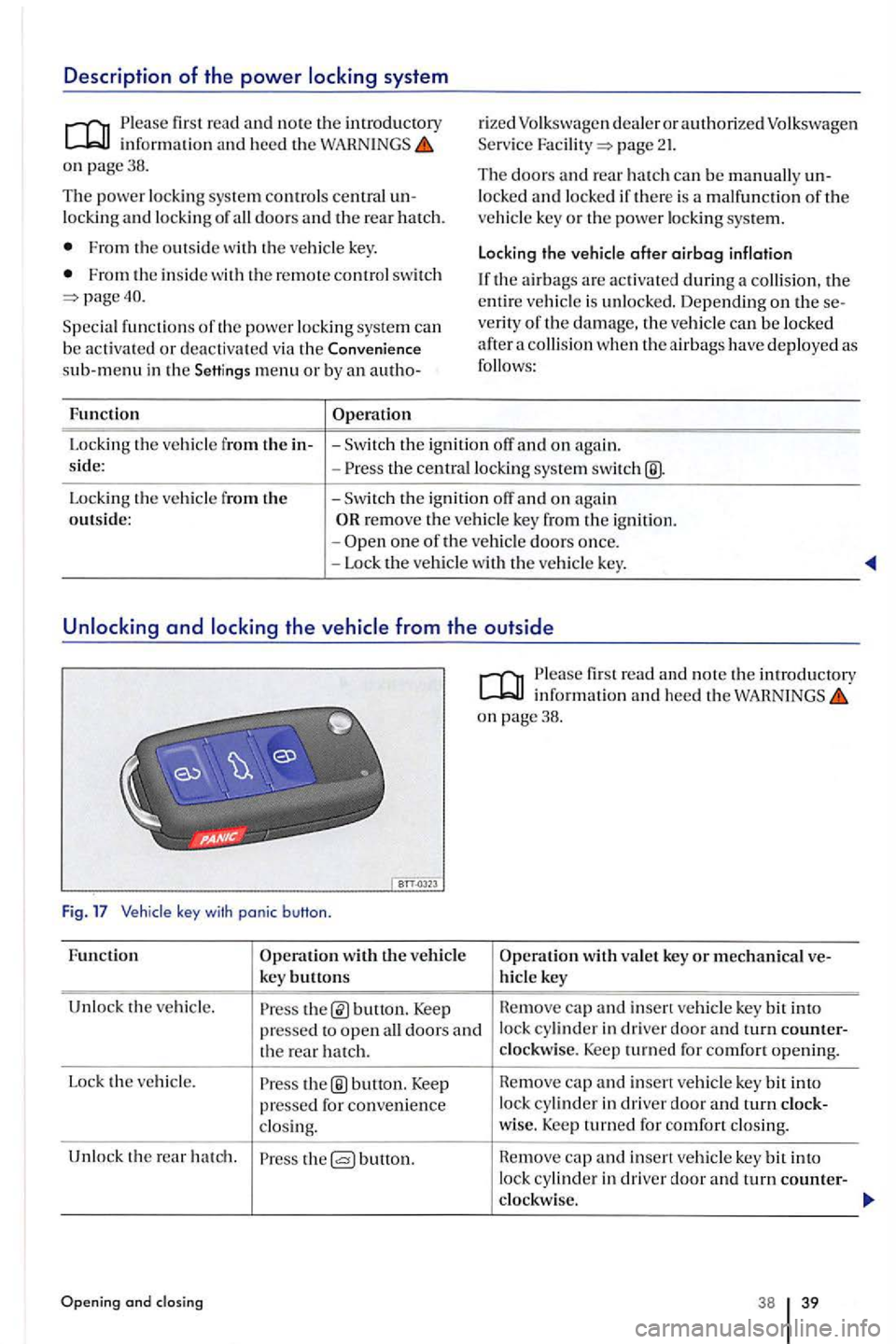
Description of the power system
firs t rea d and no te th e in troduc tory in for mation and heed the on page38.
T he pow er lockin g syst em co ntrols central un
locki ng and lock in g of all doors and the rea r hatc h .
Fro m tl1e outsid e wit h the vehicl e key.
Fro m the in sid e w ith th e remote contro l switch
Speci al fu nct io ns of the power locking syste m can
b e ac tiva ted or dea ctiva te d via the su b-m en u i n the Sett in g s menu or by an au tho-
Fun cti
on
rize d Volkswagen dealer or author ized Volkswage n
Service page 21.
T he doors an d rear h a tc h can b e manually un
l o ck e d and locke d if there is a m alf unc tio n of th e
ve hicl e key or th e power locking sys te m .
L ocki ng the vehicle
after airbag inf la tio n
the airba gs are activated during
the centra l lockin g sys tem
Locking th e ve hicle from th e
outs ide: -Swi tc h th e ig nit ion off and o n again re m ove th e vehicl e key from the ig niti on.
the
with the ve hicl e
k ey buttons
Unlo ck th e ve hicle.
firs t read and note th e introductory infor ma tion and heed th e on page38.
bunon. Keep cap and insert ve hicle key bit into
pres
sed for co nve nien ce lock i
n driver door a nd turn clock-
clo sing. w
ise. Keep turn ed for comfo rt clos ing.
U nlo ck the re a r h atc h .
butto n. cap a nd insert ve hicle key bit int o
lock cy lin der in driver door turn cowller-
clockwise.
Ope ni ng and 38 39
Page 81 of 541
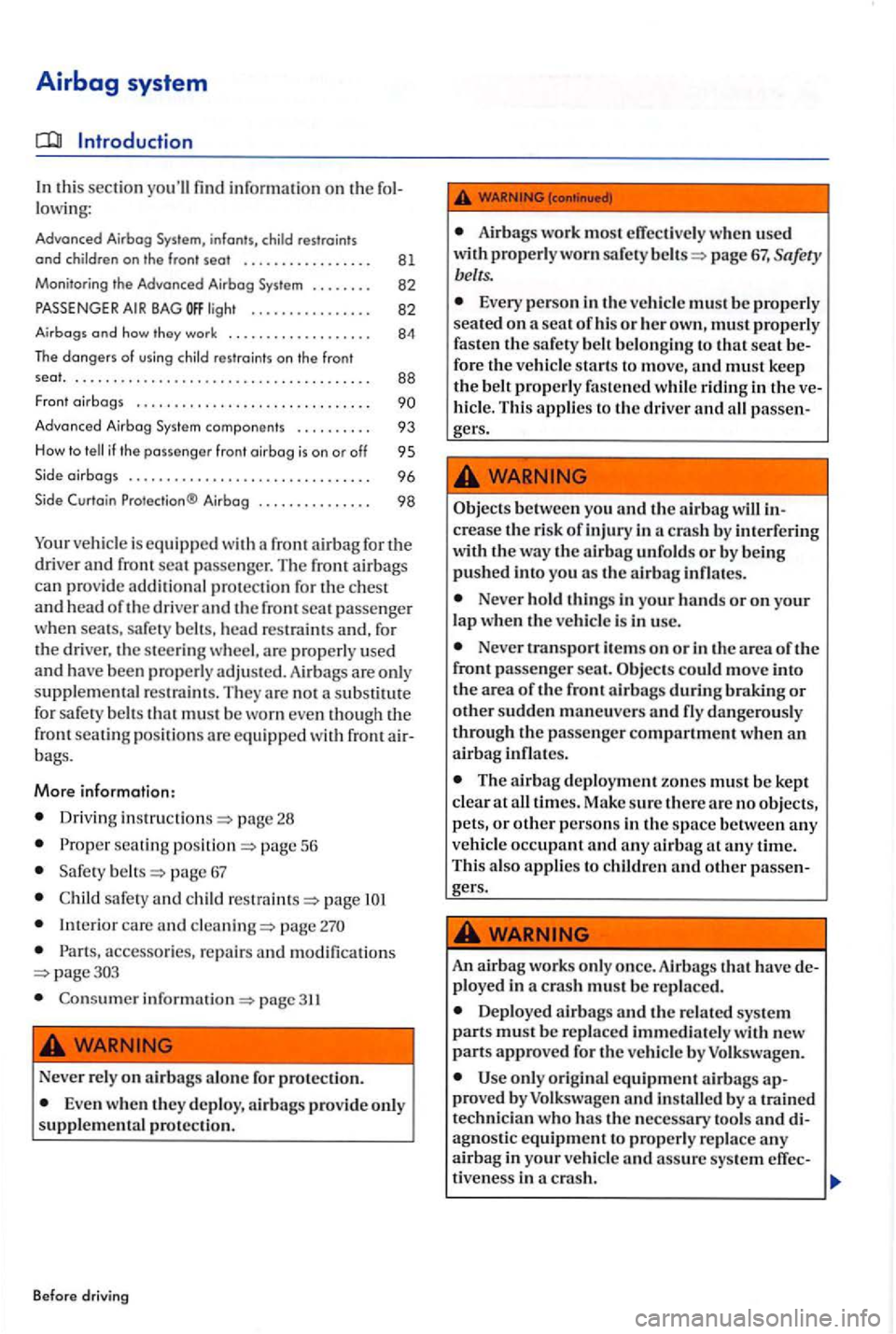
Airbag system
find information on th e fol
low ing :
Advanced Airbog
. 82
. . . . . .
Advanced Airbog Sys tem compon e nt s . . . . . . . . . . 93
H ow to if the passenger fron t oirbog is on or off 9 5
. . . . . . 98
Your vehicle is e quipped a front air bag for the
d ri ve r an d fro nt pa sse nger. The front airbag s can pro vide additional p ro tec tion fo r th e ch est and h ead of th e driver and the fro nt sea t p assenge r seats, sa fe ty belts, h ead re stra int s and, for
the driver, th e s teerin g whee l, are prop erly use d and have bee n properly adjusted. Airb ags are on ly
s u pplemental restraints. Th ey are not a su bstitut e for sa fe ty belt s th at must be wo rn eve n though front seatin g pos itions are equipp ed wit h front air
bag s.
More information:
Driv ing instru ction s=> page
seating position=> pag e 56
Safe ty belts=> page 67
sa fe ty and child pa ge
care and pag e
accessories, re pa ir s and modifica tion s pag e303
informati on=> page 311
Never rely on a irbags alone for protect io n.
Eve n when th ey deploy, airbags provide only
s uppl em ental protec tion.
Be fore driving
Airbag s work most effec tive ly w hen used
with properl y worn safe ty belt s=> page 67,
Every perso n in the ve hicl e must b e prop erl y seated on a seat of hi s or he r own, must properl y faste n th e safet y belt belongi ng to th at seat b e
for e the vehicle sta rt s to move, and must ke ep the belt properly faste n ed whil e riding in the ve
hicle. Th is a pplie s to the driv er and all
Obj ects between you an d the airbag will crease the risk of injury in a crash by interfe rin g
witl1the way the airbag unfolds or by being push ed into you as the a irbag inflates.
Never h old th ings in your hand s or on your lap when the vehicl e is in use.
Never items on or in th e area of th e
front passe nger seat. Ob jects could move into
th e a rea of the front airbag s during braking or other sudden maneu ve rs and fly dan gero usly
through the passe nge r compartment when an airbag infl ates.
The airbag deploym ent zones must be kept
clear at all tim es. Make sure there are no objects ,
pets, or ot her persons in the space be tween any ve hicl e occupant and any airb ag at an y time. Thi s also applie s to c hildr en and o ther pa sse n
gers .
WARNING-
An airb ag works o nl y once. Airbag s th a t h ave de
plo yed in a cras h must be re placed.
Deployed airbag s and the re lated sys tem
p art s must b e repla ced immediately with new parts approved for the ve hicl e by Volkswagen.
Use o nly orig inal equipment airb ags ap
prov ed by Volkswag en and by a trained
techni cian who has the necessary too ls and di
agnostic eq uipmen t to properl y replace an y airbag in your ve hi cle and assure sys te m effec-
ti veness in a c rash.
Page 83 of 541
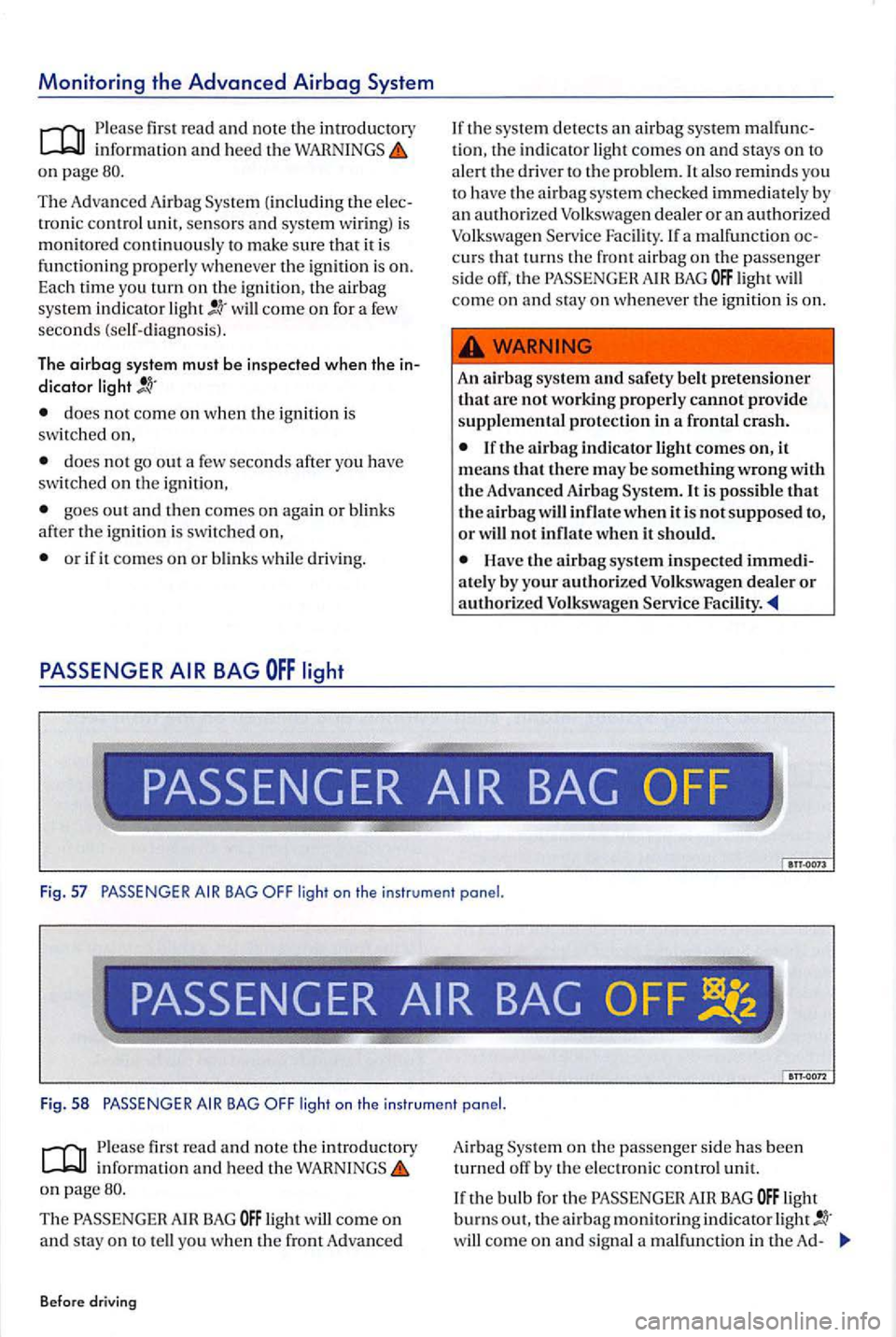
Monitoring the Advanced Airbag System
Please rea d and no te the introductory
on page80.
T he A dva n
ced Airb ag (including the e lec
troni c control unit , sensors and sys te m wiring ) is monitore d continu ously to make sure that it is
functioning properly when ever the ig nition is on. Each time you on th e ig nition , the airbag
system indicator light will come on fo r a few
seconds (se lf-d iag nosis).
The airbag system must be inspected when the indicator light
does not come on when th e ignition is swi tched on,
does n ot go out a few seconds after you have switch ed on th e ignition,
goe s out and th en comes o n again or blink s afte r th e ig n ition i s switch ed on,
o r if it comes on or blink s while dri ving.
PASSENGER
If th e sys te m d etec ts a irba g sys te m m alfun c
ti on , th e indi cator lig ht comes on and stays on to
a le n th e dri ver to th e prob le m. I also reminds yo u
to have the a irbagsys te m checke d immediat ely by an authoriz ed Volk sw agen dealer or an auth ori zed Volkswa gen Facility. !fa malfunction oc
c ur s that turns the front a irbag on th e passenger
s ide off, th e BAG
not inflate when it should.
Ha ve the airbag system inspected immediately by your authorized Volkswagen dealer or authorize d Volkswagen
Fig . 57 light on the instrum ent
PASSENGER
Fig. 5 8 BAG lig ht on the in strume nt
Plea se first rea d and note the introducto ry
on page
The
on th e passenger sid e has been turned off by th e e lec tronic control unit.
If th e bulb for the
ligh t burns out, the a irbag monitoring indicator will come on and signa l a m alfun ction in th e Ad-
Page 85 of 541
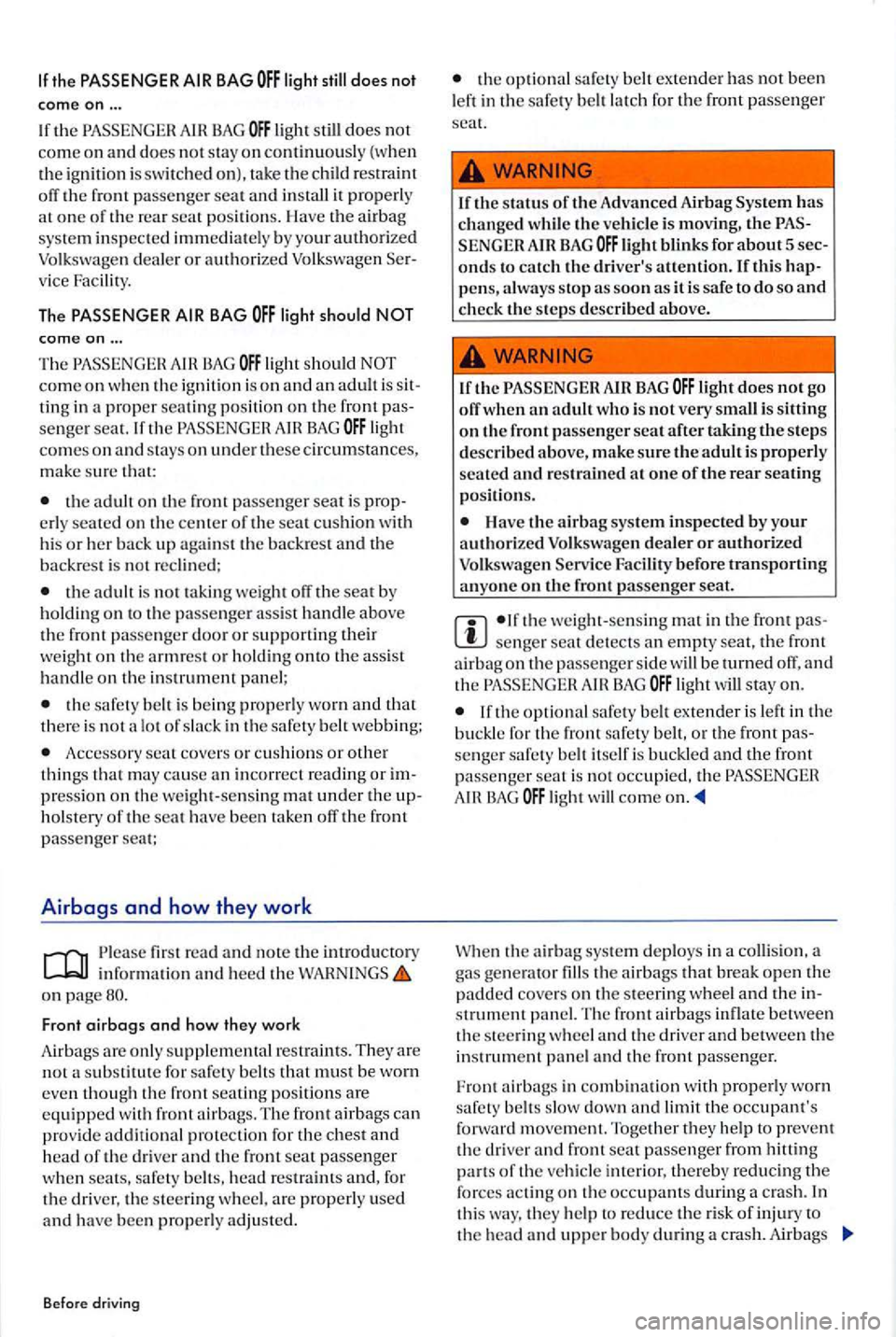
light does not
come
on ...
the ligh t
vice Facili ty.
The light should
BAG light shou ld come on w he n the ign ition is on and an adult is
the lig ht
co mes on and sta ys on unde r these circ um stances,
mak e sure that :
th e adult on the front passenger seat is
the adult is not we igh t off the seat by holding o n to t he passe nge r assis t handle abov e the front passe nger doo r or supporting their weight on th e armres t o r hold in g onto the ass ist ha ndle on the in strument panel;
t h e safet y belt is be in g properly wo rn and that th ere is no t a lo t o f s la c k in the s afet y be lt webbing;
Access ory seat covers or cu sh ions or other
thi ngs that m ay cause an incorrect reading or pression on the weight-se nsin g mat under the
fir st read and note the introd uc tory inform ation an d heed the on page 80.
Front airbags and how they work
Airbags are only supplem ental restra ints. They are not a substit ute for safety belt s that must be w orn even though th e front seatin g po sitions are equip ped wi th front airb ags. The fron t a ir bags can provid e additional prote ct ion for the chest and head of the drive r and the fr ont seat passe nger when seat s, safety belt s, h ead restraints and, for
th e dri ver, th e s teering wheel, are properly used and have been properly adju sted.
Before driving
the statu s of the Adva nced Air bag has changed whi le the vehicle is moving, the BAG ligh t blinks for about 5 seconds to catch the driver's attention . If this pens, a lways stop as soon as it is safe to do so and check the steps described above.
light does not go ofT when an adult who is not very sm all is sitting on the front passen ge r seat after taking the steps described above, make sure the adult is properly seat e d and restrained a t one of the rear seating
position s.
Have the airbag system inspected by your authorized Volkswagen dealer or authorized Volkswag en
sen ge r seat d ete cts an empty seat, th e front airba g on the passenger sid e will be tu rned off, and the light stay on.
sen ge r safety belt itself is buckled and the front passe nge r seat is no t occupied, the
the air bag sys te m deploys in a collis io n , a
ga s ge nerator fills th e a ir bags that break open the padded cove rs on the steering w heel and th e strume n t panel. The front airbags inflate between
th e s teerin g w heel and th e driver and between th e
in strumen t panel a nd th e front passenger.
Fron t air bag s in combination wit h properly wo rn
sa fety be lt s s low down and limit the occupant's forward movement. Toge ther they help to prevent th e driv er
Page 86 of 541
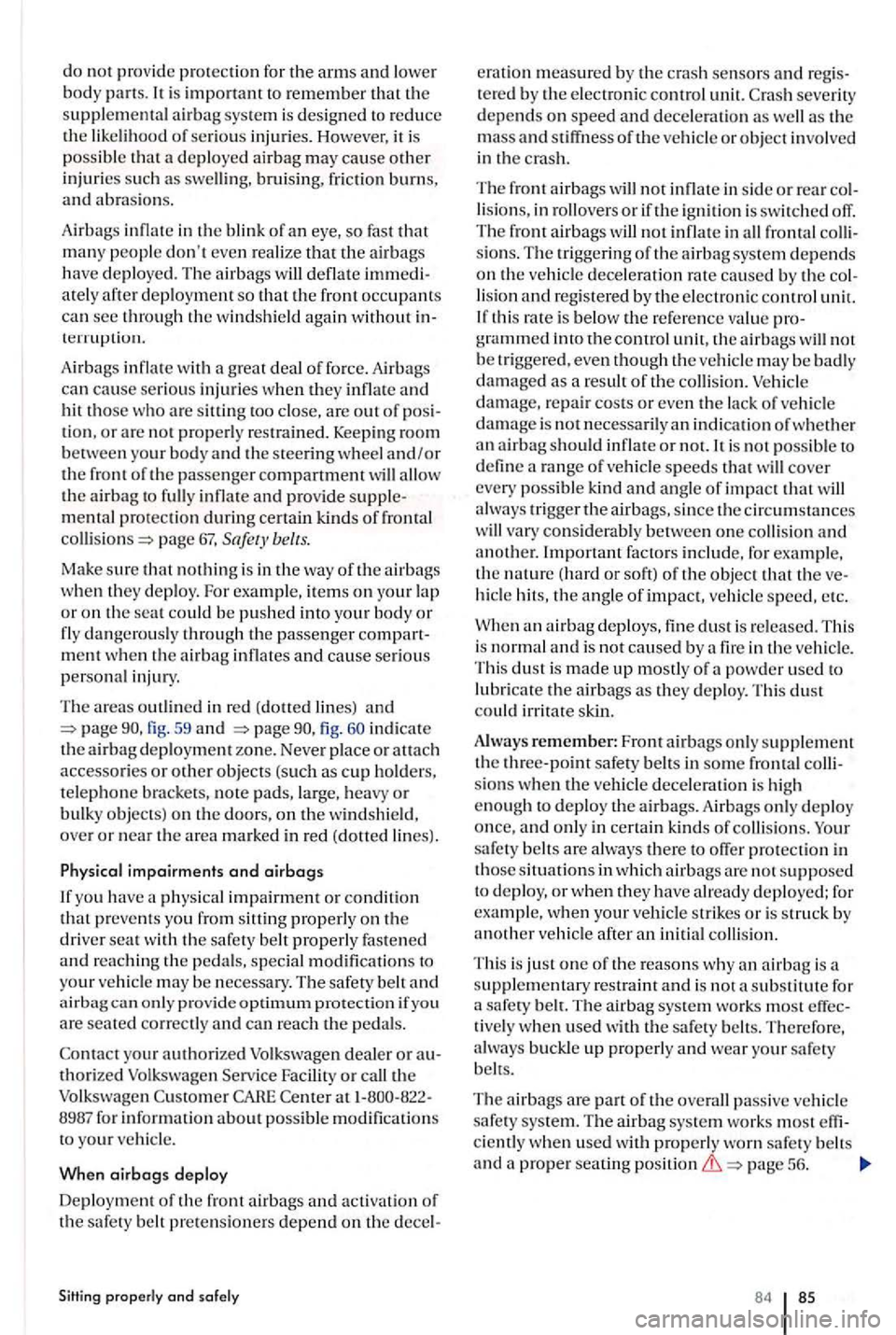
do not provide protectio n for the arms and lower body parts. is important to remember that th e
supple m ental airbag system is designed to reduce the likelihood of serious in juries. However, it is poss ibl e that d ep lo ye d airbag may cause other injurie s such as swelling, bruising, friction burns, and abrasio ns.
A irba gs inflat e in
the blink of an eye, so fast that many people don't eve n realize th a t the airbags
h ave dep loyed. The a irbags will deflate ate ly after deployment s o that th e front occupants can see th roug h the windshield again without terruption.
A ir
bags inflat e with a grea t deal of fo rce. Airbags can cause serious in juries when they infl ate and hit those who are sittin g too close, are out of
mental protection durin g certain kinds of frontal
collisio ns page 67, Safety belts.
Make s
ure that nothing is in the way of the airbags when th ey deploy. For example, items on your lap or o n th e seat could be pushed into yo ur body or fly dangero usly through the passenger ment w he n the ai rbag inflates and cause serio us personal injury.
T he areas outlined in red (dolled lines) and fig. 59 and fig. ind icate the airbag deployment zone. Never place o r aLtach
accessories or other o bjects (such as cup hold ers, telephone bracke ts, note pads, large, heavy or bulky objects) on the doors, on the w indshie ld, over or near the area marked in red (dotted lin es) .
Physical impairm ents and airbags
If yo u have a physica l impairment o r condition that prevents yo u f rom sitting properly o n the driver seat with the safety belt properly fastened
a n d reach ing the pe dal s, special modifications to
your ve hicle may be necess ary. The safety belt and airbagcan only provide optimum p rotection if you
are seated correct ly and can reach the p ed als.
thorized Volkswagen Service Facility or call the
te red by the electron ic control unit. seve rity
depends on speed and decele rati on as well as the mass and stiffn ess of the ve hicle or object in vo lved
in the cras h.
The front airbag s will not inflat e in sid e or rear lisio ns, in roll overs or if the ig niti on is swi tc h ed off .
T he front airbags will not inflate in all frontal sions. The trigger ing of th e a irbag system depends on th e ve hicle dece le rat ion rat e caused by the lisio n and registered by the electr onic control unit. If th is rat e is below the refer ence va lue grammed the control unit, th e a irba gs will not be trigge red, even though the vehicle may be badly damaged as a resu lt of the collision. Vehicl e
damage, repair costs or even the lack of ve hicl e damage is not necessarily an ind ication of whether
a n airbagshould inflat e or not. It is not possib le to
defi ne a range of vehicl e speeds w ill cove r
every possibl e kind and angle of impact that will
a lways trigger the airbag s, s ince th e c ircumstances
will vary con sid erably between one collis ion and a not her. Important facto rs include, for example , the nature (hard or soft) o f the objec t that the hicl e hit s, the angle of impact, ve hicle speed , etc.
When a n airbag deploys, fine dust i s released. This
i s normal and is not caused by fire in the ve hicle.
T hi s d ust is made up mostly of a powder used to
lub ricate the airbags as
s ions when the veh icle deceleration is high enough to depl oy the airbags. Airbags onl y deploy
once, and o nl y i n certain kinds of collisions. safet y belts are always there to offer protectio n in
th ose situ ation s in which airbags are no t s upposed to dep loy, or when they have already deployed; fo r example, when your vehicl e strikes or is st ru ck by
anothe r ve hicle after an initial coll is ion.
is just one o f the reasons w hy a n air bag is supplementary restraint and is not a substitute for a safe ty belt . The airbag syste m wo rks most
The air bags are pan of the overall passive vehicl e safe ty sys tem. The airbag system works most cie ntly when used with properly safety be lts and a proper seatin g posit ion
84 85
Page 87 of 541
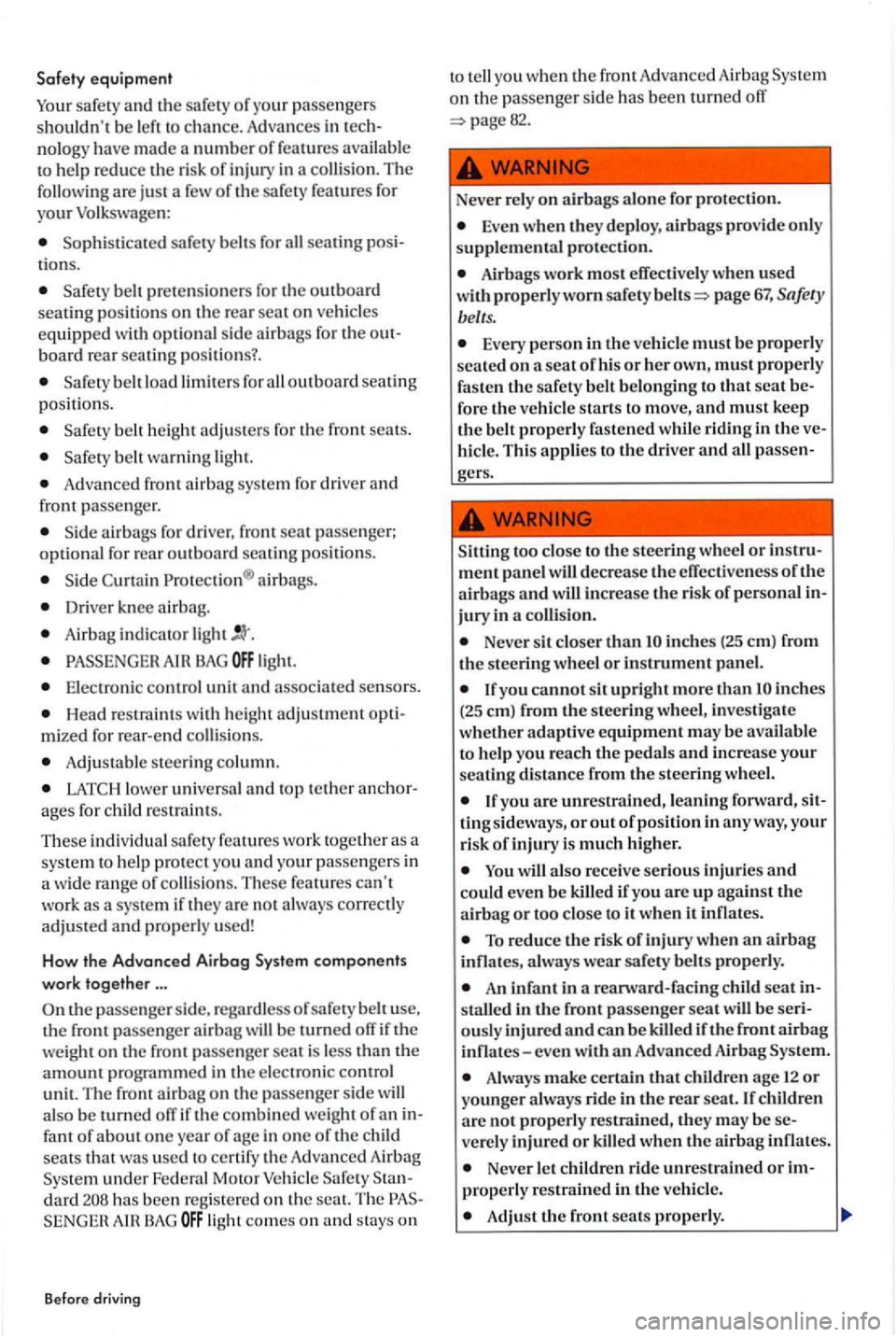
Safety equipment
safet y and the s afe ty of your p assenge rs shouldn 't be l eft to c han ce. Advances in tech
nolo gy have made a numb er of featur es available help reduce the ris k of injury in a collisio n. The follo wi ng are just a few o f th e sa fe ty features for your Volkswag en :
Soph is ticated safety belts for all seating posi
tions.
Safety belt pretensio ne rs for the outboard seatin g positi ons on the rea r seat o n ve hicl es equipped with optional side a irbags for the o ut
board rear seating positi ons?.
belt load limit ers fo r all outb oa rd seating
positions.
b elt h e ig ht adju ste rs for the front
belt warning light.
A dvanced front airba g sys tem for driver and fro nt passe nger.
airbag s.
Driver knee airbag .
Airbag indicator light
BAG light.
Ele ctronic cont rol unit and asso ciat ed senso rs.
Head res traint s w ith heig ht adju stment opt imized for rear -end collisio ns.
Adju stabl e stee rin g column.
lo w er univer sa l and top te th er an chor
age s for child restraint s.
These individual safety wo rk tog eth er as sys te m t o help pro tect yo u and your passenger s in w id e rang e of collisio ns. Th ese features can't
work as a syste m if they are no t a lwa ys correctly
adju ste d and prope rly used!
How the Advanced Airbag System components
work together ...
in
fan t of about one yea r o f ag e in one of th e c hild
seats u sed to certif y th e Adva nced Airb ag under Federa l Motor dard h as been regis te re d on th e seat. Th e AI sta ys on
Before driv ing
o n th e passenge r side has been turned off
Neve r rely on airbags alone for protec tion.
Even wh en they depl oy, airbags provide only
supplemental protection.
Airbag s work most effec tive ly when used with properly worn safe ty page 67, Safety
belt
s.
Every person in ve hicle must be prope rl y
se ated on a seal of his or he r own, must prope rl y
fasten the s afety belt belonging to that seat be
fore th e ve hicle start s to move, and must keep the belt properly fas tened w hil e riding in the ve
hicle. This applies to the dri ver and all passen-
too close to the steering wheel or instru
m ent panel will dec rease the effectiveness of th e
airbags and will increase the risk of personal in
jury in a coUision .
Never sit closer than inche s (25 em ) from the s teering whee l or instrument panel.
If yo u cannot sit upright more th an inch es (25 em) from the steering wheel, investigat e
whether adaptive equipment may be ava ilable
to help you reach the pedal s and increase your seating di stance from the steering wheel.
If you are unres trained , leaning fonvard, sit
tingsideway s, or out of position in anyway, your ris k of injury is m uch higher.
To reduce the risk of injury w hen an airbag always wear safety belt s properl y.
A n infant in a reanvard-facing child seat in
s talled in the front passe nge r seat w ill be seri
ously injured an d ca n b e killed if the front airbag
inflates-even with an Advanced Airbag
Always make certai n that children age 12 or younger alway s ride in the re ar seat. If childre n
are not properl y re stra in ed, they may be se
ve rel y injured or killed when th e infl ates.
Never le t children ride unres trained or im properly re strain ed in th e ve hicl e.
Adjust the front seats properly.
Page 91 of 541
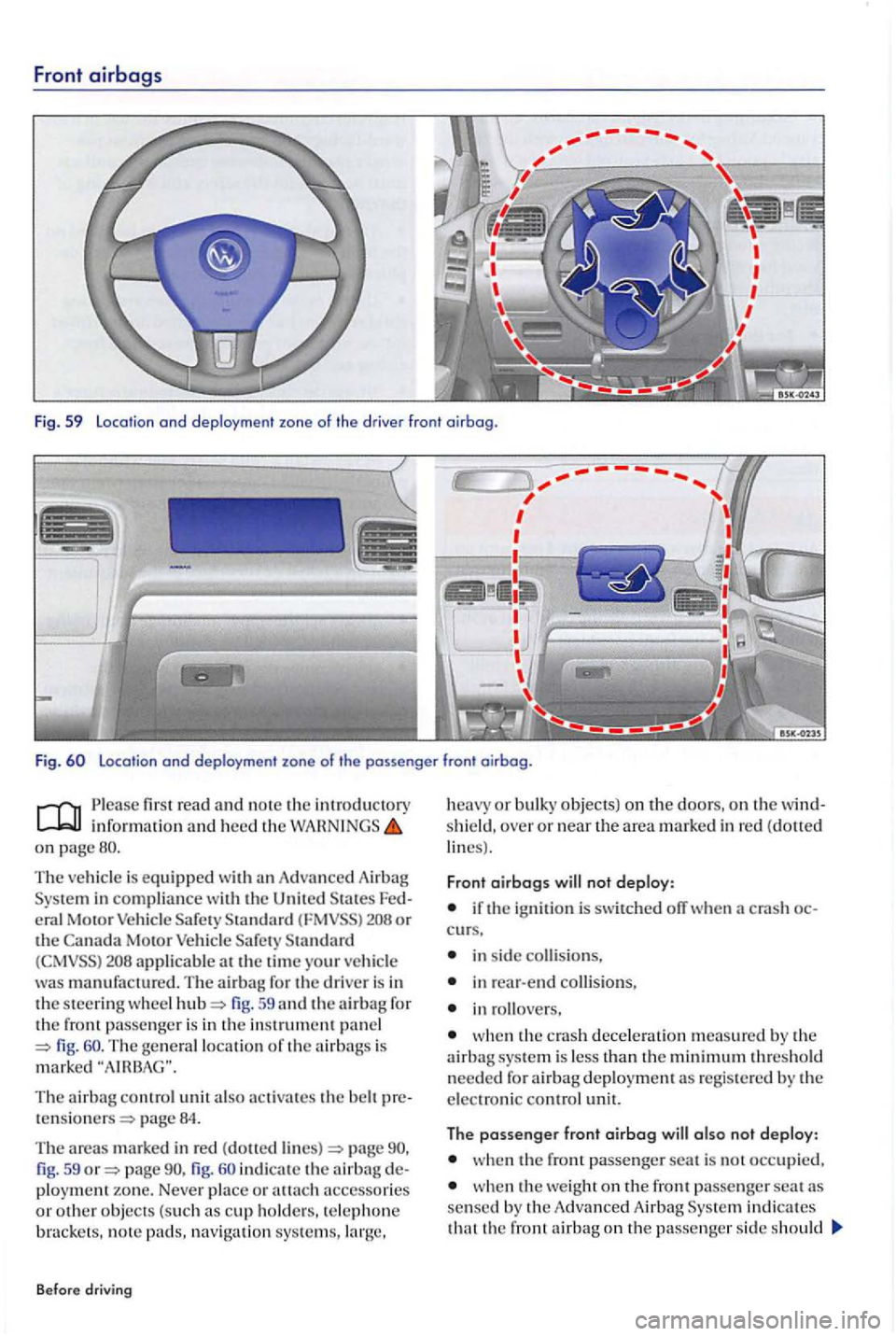
Front airbags
Fig . 59 location ond deploy ment zone of the driver front oirbog.
Fig .
60 location and deployment zone of the passenger front oirbog .
read and no te the introductory
on page 80 .
The ve hicle is equippe d w ith
208 applicable at the tim e your vehicl e was manufactured. The a irbag for the driver is in the steerin g fig. 59 and the for the fron t passeng er is in the instrument panel 60 . The gene ra l locatio n of the air bags is
m arked
The activa tes the belt te n sione rs page 84.
Th e a r
eas marke d in re d (do tted page fig . 59 page fig . indi cate the airb ag plo ym ent zone. Never place or
naviga tion systems,
Before driving
heavy or bulky objects ) on the doors, on the s hi eld , o ve r or near the area marked in re d (dotted lin es) .
Front oirbogs not deploy:
if th e ig n itio n is switched off when cra sh
in sid e collision s,
in rear-end collis ions,
in roll overs.
when the cra sh d ecele rat io n measured by the airbag syste m is less than the minimum threshol d nee d ed f or airbag deployment as regis te red by the
e lectroni c control unit.
The passenger front oirbog
when the front passenger seat i s not occupied,
w hen the weight on the fron t passenger seat as sensed by the Advanced Airbag in dica tes that t he front airbag on the passe nge r sid e should
Page 93 of 541

Always make sure nothing is in the front airbag deploym ent zone that could be struck by the airbag when it inflates.
Never hold things or on your lap when the vehicle is in use.
Never place accesso ries or other objects
(such as cup holders, tel ephone brackets, note pads, navigation systems, or things that are large, heavy, or bulky) on the doors; never attach them to the doors or the windshield; never place th em over or near or attach them to the area marked
fig. 59 or 91, fig.
Never attach objects to the windshield above the passenger front airbag, such as accessory navigation units or music player s.
Never recline th e front passenger seat to transport objects. can also move into the deployment area of the side airbags or the front airbag during breaking or in a sudden maneuver. near th e a irbags can fly dangerously through the pass enger compartment and cause injury, particularly when the seat is reclined and the airbags inflate.
Always make sure that there is nothing on the front passe nger seat that will cause the weightsensing mat in the scat to signal to theAirbag that the scat is occupied by a person when it i s not, or to signal that it is occupied by someone who is heav ie r than the person actually
sitting on th e sca t. The weight of th e object could cause the passenger front airbag to be turned on when it should be off, or could cause the airbag to work in a way that is differ ent from the way it
would have worked without the added weight.
Alwa ys make sure that nothing is on the front passenger seat when the backrest is folded
forward. Even light objec ts could be pushed into the seat cu shi on and cause th e weight-sensing mat in the seat to re gister enough weight to turn the airbag on.
Never usc solvents or cleaners on the steering wheel horn pad or instrument panel, because they can damage the
Before driving
airbag cover or change the stiffne ss or strength of the material so that the airbag cannot deploy and protect properly. When cleaning the hom pad and instrumen t p anel, use only a soft, dry cloth or a cloth moist en ed
with plain water.
A front seat passenger, especially an infant or small child, will be seriously injured and could
eve n be killed if he or she is
Although the Advanced Airbag has been designed to switch off when an infant or child is on the front passenger seat in a child seat that was used during the certification
process for the Advanced Airbag no one can guarantee with absolute certainty that the airbag never deploy under these particular conditions in all conceivable situations for the duration of the vehicle 's use.
For their own safety, all children, especially those 12 years and younger, mus t always sit on the back seat, properly restrained for their age and size.
Facility. A lit indicator light means the airbag may not work properly if
activated in a crash.